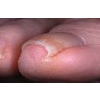
Ingrown toenails are a condition when the nails dig into the skin as a pathway for growth.
This occurs in cases when the toenail is deformed by small shoes applying pressure from both sides. This can lead to the nail pinching and digging into the skin.
How to deal with ingrown toenails
It’s common to see a dermatologist for the treatment of ingrown toenails. However, depending on the condition of the nail, one may visit a surgeon or a plastic surgeon. Regardless, it is recommended to first visit a dermatologist.
It is probably a valid option to visit surgeons after meeting a dermatologist.
Main treatments include:
- Removing a section of the nail to create a artificial nail, and minimise the angle of growth.
- Inserting a highly elastic wire to minimise the angle of growth overtime.
Like braces on teeth, these methods take a long time. If these methods are ineffective, surgery also becomes an option.
Furthermore, a typical surgeon may just cut the nail for treatment, yet other plastic surgery clinics may undergo methods to remove the entire nail. In fact treatment using wire can’t be covered by insurance and costs from 4000 to 20,000 yen.
Different treatment for ingrown toenails depending on the hospital
The treatment for ingrown toenails has not been standardised, is based heavily on treatment culture of the hospital and the judgement of the doctor. It is recommended to research a hospital before you visit for treatment.
Regardless, it’s better to have ingrown toenails treated earlier. If the condition has been left unattended for a prolonged period of time, there is a risk of infection in the bones. Any signs of ingrown toenails creating any discharge or causing pain requires the immediate attention of a doctor.
Furthermore, the ingrown toenail may cause some inflammation. In such a case it would become impossible to even wear shoes due to the pain. Immediate treatment would be required.
。
Prevention
Cutting the bent toenail and wearing shoes with a circular tip.

